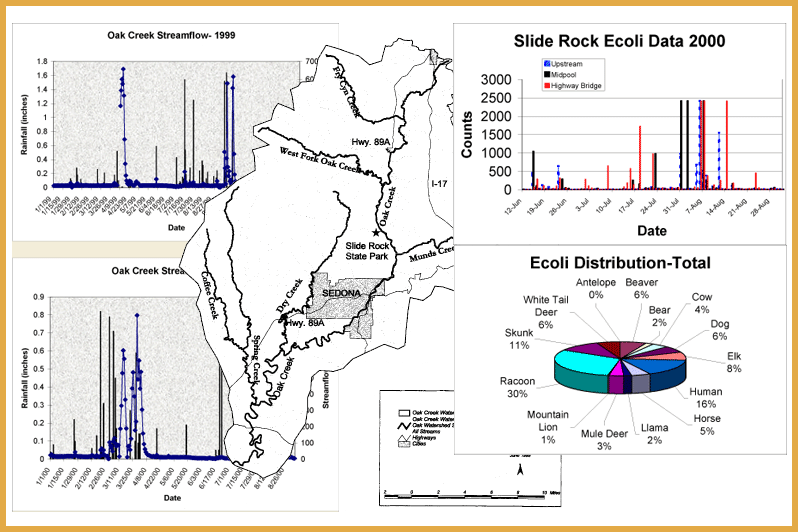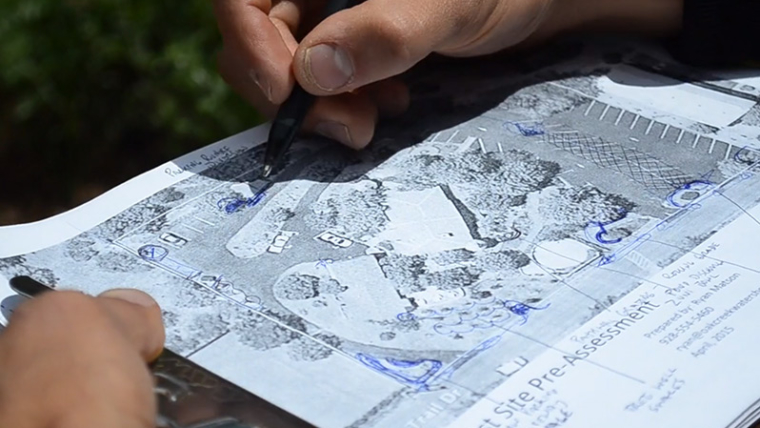November 7th, 2002
Approved at a general meeting of the Oak Creek Watershed Council
This Watershed Based Plan (formerly Watershed Restoration Action Strategy…WRAS) took over two years to prepare and represents the combined efforts of all members of the Oak Creek Watershed Council. A special thanks to Doug Cullinane, P.E., for his effort writing the first draft and subsequent revisions. Also, thanks to Dr. Gordon Southam, staff of the Arizona Department of Environmental Quality, and the United States Forest Service for their valuable input. This Plan is a work-in-progress document. Frequent review, changes, and updates are encouraged.
1. Mission (2012)
The Oak Creek Watershed Council is founded on the principle that a voluntary association of members of the watershed community, working together to understand both the watershed and each other, can best protect the Oak Creek Watershed environment and preserve the integrity of its outstanding watercourse, Oak Creek.
2. Goals and Objectives
A. GOALS OF THE PLAN:
- Conserve natural resources and enhance the environment for all users.
- Sustain, improve and diversify recreational opportunities.
- Improve water quality and water quantity.
- Sustain, enhance and improve the environment for wildlife.
- Reduce damage from storms, floods, man-made activities and/or natural disasters.
- Engage and maintain public and governmental involvement including Local, State, Federal, and Tribal governments, through public outreach and education. A few of the specific outreach goals include:
- Development and enhancement of a Web site
- Development of a multi-media, water quality/ water quantity campaign.
- Development of a Speakers Bureau to address local groups on the existence of the Oak Creek Watershed Council and its programs.
B. OBJECTIVES OF THE PLAN:
- Gain and share a better understanding of the characteristics and dynamics of the watershed and how it impacts the quality of life of those who live within the watershed.
- Prepare comprehensive lists of issues and concerns of the populace and of local, state. and federal governments relating to point and non-point source pollution in the watershed.
- Identify and quantify the origins of point and non-point source pollution in the watershed.
- Establish or aid in the development of monitoring programs for point and non-point source pollution.
- Encourage action agencies, individuals and other governmental and non-governmental entities to use locally appropriate management practices (LAMPs) to reduce or eliminate point and non-point source pollution.
- Encourage fair and equitable actions through public involvement.
- Coordinate environmental planning and implementation with agencies, governments, environmental advocacy groups, and other private sector interests.
- Provide a forum to foster ongoing evaluation and improvement of environmental programs and regulations.
- Promote and sponsor public educational and outreach seminars and workshops for participants interested in learning about the watershed, water quality and quantity issues, and develop possible solutions for improvement.
- Assist local communities and groups in priority setting for environmental problems and provide a sound technical basis to support environmental decisions.
- Organize, store, and distribute information to the public on the watershed in general, upland areas, reaches of the river, urban areas, and valley areas.
- Obtain grants and contracts related to watershed resource issues and concerns.
3. Organizational Structure
A. 2012 CHAIRMAN, KURT HARRIS, P.E., ADOT VICE-CHAIRMAN, JOSHUA MYERS, ENVIRONMENTAL HEALTH SPECIALIST, YAVAPAI COUNTY DEVELOPMENT SERVICES
B. ACTIVE MEMBERS/REPRESENTATIVES
1. Local Stakeholder Groups
- Homeowner Associations
- Recreation Resource Management
- Arizona Watershed Alliance
- Private businesses
2. University/Research
- NAU – Engineering Dept
- NAU – Biology
3. City/County Government
- City of Sedona
- Coconino County
4. State/Federal Agencies
- US Forest Service
- Arizona State Parks Department
- Arizona Game and Fish Department
- Arizona Department of Transportation
- Arizona Department of Environmental Quality
- Arizona Department of Water Resources
- US Fish and Wildlife
5. Sedona Fire District
4. Watershed Description
Oak Creek Canyon is a narrow strip of deep-canyon land extending from the Mogollon Rim thirteen miles southward (downstream) to the northern limit of Sedona. Breadth ranges from one mile at the northern tip to approximately three miles in the South. Although Oak Creek Canyon encompasses 5,833 acres (up to the Mogollon rim), only 907 acres are located on slope less than 15%. The Oak Creek floodplain is considered to be 290 acres.
Oak Creek flows for 50 miles in a southwestern direction to join the Verde River near Cornville, Arizona. Oak Creek drops 2500 feet through a steep-walled canyon in the upper reaches to gently rolling hills and plateaus in the lower reaches. The stream originates from springs located just above Sterling Springs Fish Hatchery and is augmented by flows from West Fork of Oak Creek, Munds Creek, springs near Indian Gardens, and additional springs located near Page Springs Fish Hatchery and Spring Creek.
GEOLOGY
Oak Creek resulted from uplift of the 600 million-year-old Colorado Plateau near Flagstaff. This edge is distinguished by the Mogollon Rim, an erosional rampart 900- 4500 feet high. Near the head of the canyon it is 1500 feet deep and relatively narrow. From here the descends to Sedona, about 12 miles, where the canyon is 2500 feet deep and opens to almost a mile across. As the creek flows south it is flanked by 600-foot tall cliffs of Kaibab Limestone, Toroweap Formation and Coconino Sandstone.
Near Slide Rock, a series of deep pools were formed in the red sandstone of the Supai Formation. Farther downstream, near Wilson Canyon, the creek has carved a gorge in the exposed Redwall Limestone. Approaching the town of Sedona, the canyon opens to a spectacular series of high red sandstone buttes which are part of the Supai Formation. South of Sedona, the creek has developed incised meanders, flowing across an ancient lakebed that is part of the Verde Formation. Parts of this area are capped by gray lava buttes and mesas with chalky gray-white lake deposits of the Verde Formation (Twenter and Metzger, 1963; Levings, 1980; ADHS, 1985).
LAND USE
State Route 89A, the first Congressionally designated Scenic Highway, paralleling Oak Creek within 100 meters in many areas, accounts for 54.5 acres. The U.S. Forest Service and State Parks have developed 123 acres as campgrounds, parking lots, picnic areas and scenic views. Private residences and stream-side businesses utilize 245 acres. Of the private residential sites, only 300 of 450 sites that have obtained wastewater permits have been developed. The remaining 200 acres of is undeveloped, most of which has been subdivided into private ownership parcels (slope < 15%). Approximately 150 homes in Oak Creek canyon utilize septic leach field systems to treat fecal waste (Stafford, 1993).
State Trust land, located above and below the Mogollon Rim, is used for livestock grazing, wildlife habitat, dispersed recreation, fuel wood, and timber harvest. Grazing and natural animal populations represent a potential impact to Oak Creek water quality. Oak Creek Canyon area is managed to emphasize visual quality, watershed condition, developed and dispersed recreation, visitor services and cold-water fisheries habitat. The Forest Service maintains five campgrounds and a picnic area in Oak Creek Canyon as well as a day-use full-body contact recreation area (Grasshopper Point).
Figure 1. Oak Creek Watershed

The most intensive land use in the Oak Creek watershed occurs in the uppermost region adjacent to the City of Flagstaff. The Forest Highlands, Mountainaire and Kachina Village subdivisions are located near in the area around the I-17 and Highway 89A intersection. All of these areas are near Pumphouse Wash, one of the tributaries to Oak Creek.
Within Oak Creek Canyon, Pine Flats is the uppermost-developed area. Approximately 9.2 acres at Pine Flats is zoned residential, subdivided into 82 individual lots containing permanent single-family residences. In addition, there is a small chapel and a 2.6-acre commercial zone on which the Manresa Retreat and associated facilities are located.
About one-half mile south of Pine Flats is the US Forest Service owned Troutdale Ranch property. This 5-acre parcel of land historically contained three single-family dwellings; the old buildings were replaced with more modern structures in the 1980s. Half of this property is located within the floodplain of Oak Creek. Just three-quarters of a mile south of Troutdale Ranch there is a 1.2-acre parcel with one single-family residence.
Proceeding south, about one-half mile north of the Confluence of West Fork (Oak Creek) with Oak Creek, is another privately owned area known as the Rosa Thomas Tracts. This area is topographically flat and contains an 11-acre subdivision with 18 separate parcels (one single family residence per parcel). In the general vicinity of the confluence, an additional 28 parcels on 32.6 acres contain single-family residences (one each); portions of each parcel are encumbered by the floodplain of Oak Creek.
In the vicinity of Don Hoel’s Cabins and the Forest Houses Resort there are 20 single- family residences, 24 small cabins, a general store, and a Forest Service Fire Station located on approximately 59 acres.
The next section of private land going south along 89-A contains the Junipine Resort (10.7 acres) and Garlands Resort (8.9 acres). Junipine Resort historically included 18 small cabins, a general store and dining facilities. In the late 1980s most of the buildings were replaced with a 50-unit time-share resort. There is still a restaurant, bar, and general store, as well as one single-family residence. On the west side of Oak Creek, across from Junipine, is a 20-acre area that has been developed into 18 private single-family residential lots. Garlands Resort consists of a lodge and dining facility, 17 small cabins, the owner’s residence, two employee residences, outbuildings, and two orchards on this property.
Traveling south towards Sedona, the next private land encountered is a 46.7-acre parcel located immediately south of the Slide Rock Bridge, which has become part of Slide Rock State Park. Six-tenths of a mile beyond are 5.9-acres subdivided into 17 individual parcels (single-family residences); adjacent is Slide Rock Lodge, which sits on 2.9 acres and has 20 motel units, a small coffee shop, and a residence for the operator.
One mile south of Slide Rock Lodge is the Rancho Shangri-La Subdivision. Approximately 9 acres, there are 38 individual lots zoned for single-family residences, though only about half of the lots contain dwellings.
Twin Oaks Restaurant and three small homes are located about one mile below Shangri- La. On the creek side of the road, the Hidden Oaks Mobil Park consists of 19 travel trailers, three mobile homes and eight houses; all of these dwellings are permanent residences. The number of dwellings situated closely together makes for a very high density of residential land use on a relatively small area. Oak Creek Terrace Motel, with 9 motel units is located on the east side of Highway 89-A just south of Hidden Oaks. Creek Side Mobil Village occupies the southernmost portion of land adjacent to Oak Creek Terrace. There are 16 mobile homes in which residents live year-round.
At the confluence of
Munds Wash and Oak Creek, there are 53.8 acres of private lands, primarily on
the east side of Highway 89-A. Within this area there are approximately 45
trailers or mobile homes (permanent) and 20-25 single-family residences. The
two most heavily population subdivisions are Indian Gardens Terrace Trailer
Park and Twin Springs Terrace Mobile Home Subdivision. There are additional
lots that may be developed in the Twin Springs Terrace area; some lots are
located within the Oak Creek Floodplain. Indian Gardens and adjacent private
property contain an additional 12 single-family residences, 8 mobile homes, and
31 trailers. The entire trailer complex is located within the Oak Creek
Floodplain.
Two miles north of Midgely Bridge are 50 acres of developed land. Four
single-family residences lie partially in the Oak Creek Floodplain. The Rainbow
Trailer Park encompasses about 8.3 acres that support approximately 75 travel
trailers and 18 mobile homes. The Rainbow Trout Farm, which sits on 1.7 acres,
operates this property. Development includes a quarter-acre pond, one hatchery
building, a cleaning house, a barn, seven trailers for employees, and fish
tanks capable of supporting 2.5 million trout per year.
About one half mile below Rainbow Trout Farm is another 40-acre area made up of
five subunits. Developed areas include the Terracotta Inn which has four small
cottages, two duplexes, one single family residence with a guest addition, and
a couple of other buildings. The Briarpatch Mobile Home Park contains 18 mobile
homes and one residence. Six additional residences are located close by, along
with 22 acres which may now be developed.
Stream Flow Characteristics
The Oak Creek watershed is approximately 464 square miles and its elevation varies from 8460 feet to 3180 feet. Oak Creek arises from a series of springs at the head of Oak Creek Canyon. Water recharging from the Mogollon Rim percolates through the Coconino Sandstone and fractures along the Oak Creek fault, feeding the upper reaches of Oak Creek. The regional aquifer is composed of the Verde Formation, Coconino Sandstone, Supai Formation, Redwall Limestone, Martin Formation, and Tepeats Sandstone.
Regional groundwater flow is to the southwest, with the exception of a small region of north and northeasterly flow above the Rim. Groundwater depths range from 200 to over 500 feet below land surface. Seeps and springs feed the alluvium along the Creek, supplementing baseflow from the regional aquifer. The portion of the watershed below the Rim experiences little or no recharge since in most months evaporation exceeds precipitation. However, during the winter months there may be some recharge since precipitation exceeds evaporation.
There are five major tributaries to Oak Creek: Pumphouse Wash, West Fork Oak Creek, Munds Canyon, Dry Creek and Spring Creek. Oak Creek, West Fork, and Spring Creek have perennial flow while the others are intermittent. The areas draining into the upper reaches of Oak Creek are characterized by high relief, with a multitude of steep-walled side canyons.
Baseflow near the headwaters of Oak Creek is approximately 3-5 cubic feet per second (cfs). With tributary and groundwater contributions, baseflow increases to approximately 18 cfs at Slide Rock and 24 cfs at the Sedona gage. From Sedona to Cornville, Oak Creek is a losing reach as baselflow near the Verde River decreases to 21 cfs. The average discharge of Oak Creek at the Cornville USGS gage is 83.4 cfs, with a maximum of 12,000 cfs showing the extreme variability in seasonal flow.
A streamflow gage and a precipitation gage exists at Slide Rock State Park, which are maintained by the Arizona State Parks Department. The recorded stream flow measurements for 1999 and 2000 are presented in the following charts.
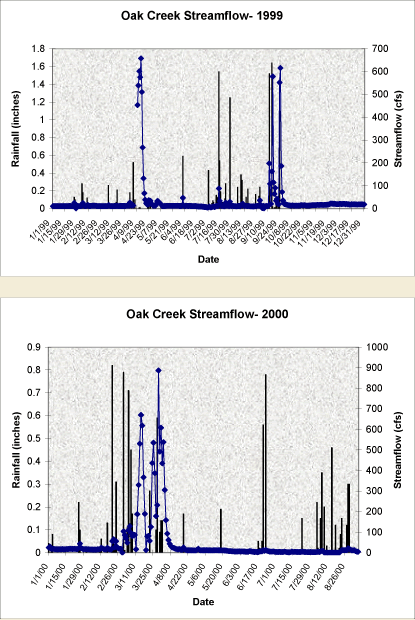
An interesting phenomenon that occurs with the stream flow in Oak Creek is the increase in flow during periods of no rainfall. This indicates the strong influence springs have on streamflow. The graph below illustrates the phenomenon during the summer of 2000.
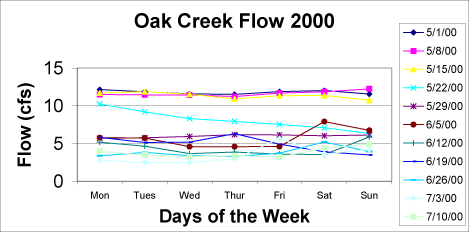
Water Quality Characteristics
Water Quality Standards and Designated Uses
Arizona sets numeric and narrative surface water standards for each waterbody based on the uses people and wildlife make of the water. All waterbodies have one of the Aquatic & Wildlife categories and have either a Full Body Contact or Partial Body Contact designated use.
The following table shows the designated uses for Oak Creek and associated tributaries.
| Waterbody | Designated Uses |
| Oak Creek | A&Wc, FC, FBC, DWS, AgI, AgL |
| West Fork of Oak Creek | A&Ww, FC, FBC, DWS, AgL |
| Pumphouse Wash | A&Ww, FC, FBC, DWS, AgI, AgL |
| Munds Creek | A&Ww, FC, FBC, DWS, AgI, AgL |
| Dry Creek | A&Ww, FC, FBC, DWS, AgI, AgL |
| Spring Creek | A&Ww, FC, FBC, DWS, AgI, AgL |
From ADEQ, 1996
Aquatic & Wildlife
coldwater (A&Wc), and warmwater (A&Ww), Fish Consumption (FC), Full
Body Contact (FBC), Domestic Water Source (DWS), Agricuture-Irrigation (AgI),
and Agriculture-Livestock Watering (AgL).
Lower Oak Creek (below the 5000-foot elevation) is proposed for a standards
change in the next triennial review. Based on macroinvertebrate community type,
this section of Oak Creek would be redesignated as Aquatic & Wildlife
warmwater (A&Ww).
ADEQ with the approval of the Environmental Protection Agency has developed
numeric standards that related to particular designated uses.
Unique Waters Designation (2012: Oak Creek is now classified as an Outstanding Arizona Water (OAW))
The Arizona Surface Water Quality Standards classify Oak Creek and the West Fork of Oak Creek as Tier II Unique Waters subject to special protection and standards. The uniques Waters designation and associated Antidegradation Rule have been consistently interpreted by ADEQ to preclude any new or additional pollutant sources in Oak Creek or West Fork Creek. Other tributaries including Munds Creek, Dry Creek, and Spring Creek have only “regular” (non-Unique Waters) status and standards, but any sources in these streams may be limited beyond “regular” standards unless it is shown that there will not be any degradation to Oak Creek.
Because of its Unique Waters designation, the following water quality standards have been prescribed to Oak Creek including the West Fork of Oak Creek.
| Parameter | Standard |
| pH (standard units) | No change due to discharge |
| Nitrogen (total) |
1.00 mg/L (annual
mean) 1.50 mg/L (90th percentile) 2.50 mg/L (single sample maximum) |
| Phosphorus (total) |
0.10 mg/L (annual
mean) 0.25 mg/L (90th percentile) 0.30 mg/L (single sample maximum) |
| Chromium (as Cr dissolved) | 5 µg/L |
| Turbidity change due to discharge | 3 NTU |
Water Quality Data
The Status of Water Quality in Arizona, 305(b) Report (ADEQ, 2000) an assessment of the water quality conditions was conducted. The following table shows the water quality of streams in the Oak Creek watershed.
| Waterbody | Designated Use Support | Stressors | Assessment Comments |
|
Munds Creek headwaters-Oak Creek 17 miles AZ15060202-415 | Attaining | ADEQ collected a total of 15 samples at 5 sites in 1997-1998. Reach is assessed as “inconclusive” and added to the Planning List due to lack of core parameters and seasonal representation. 2 out of 12 samples exceeded the turbidity standard of 50 NTU’s. (The mean range of results were 4-69 NTU). Nutrient TMDL completed in 1999. | |
|
Oak Creek West
Fork headwaters-Oak Creek 16 miles AZ15060202-020 | Inconclusive | Assessed as inconclusive and added to the Planning List due to insufficient sampling events | |
|
Oak Creek headwaters-West Fork 7 miles AZ15060202-019 | Inconclusive | ADEQ and AGFD collected a total of 9 samples at 5 sites in 1996-1998. Added to Planning List due to turbidity exceedance and missing core parameters (beryllium and boron). 1 out of 9 samples exceeded the turbidity standard of 10 NTU’s for A&Wc, with the mean range of result of 1-20 NTU. Nutrient TMDL completed in 1999. | |
|
Oak Creek Slide Rock 1 mile AZ15060202-018 | Not Attaining | E. coli | Slide Rock State Park collected a total of 4177 E. coli samples at 5 sites in 1996-2000. 75 out of 4177 samples exceeded the E. coli standard of 580 CFU/100ml, with the range of results 1-2491. Added to Planning List for TMDL monitoring and lack of core parameters. |
|
Oak Creek West Fork-Dry Creek (except Slide Rock) 24 miles AZ15060202-018 | Impaired | Turbidity | ADEQ collected a total of 44 samples from 8 sites in 1996-2000. 9 out of 42 turbidity samples exceeded the standard of 10 NTU’s for A&Wc with the mean range 1-1000. Nutrient TMDL completed in 1999. |
|
Oak Creek Dry Creek-Spring 10 miles AZ15060202-017 | Inconclusive | ADEQ collected a total of 4 samples at 3 sites in 1996-1998. Assessed as “attaining some uses”. 3 out of 4 samples exceeded the turbidity standard of 10 NTU’s with the range 1-25 NTU. Added to Planning List due to turbidity exceedances and lack of core parameters (bacteria aTMDL completed in 1999. | |
|
Oak Creek Spring-Verde River 13 miles AZ15060202-016 | Inconclusive | ADEQ collected a total of two samples at two sites in 1998. 1 out of 2 samples exceeded the standard for turbidity (A&Wc) of 10 NTU’s with the mean range 23. Added to the Planning List due to lack of sampling events and core parametric coverage. Nutrient TMDL completed in 1999. | |
|
Pumphouse Wash Headwaters-Oak Creek 8 miles AZ15060202-442 | Inconclusive | ADEQ collected a total of 10 samples at 4 sites in 1997-1998. Reach assessed as “attaining some uses”. Added to Planning List due to insufficient core parameters (fluoride and boron). | |
|
Spring Creek Coffee Creek-Oak Creek 7 miles AZ15060202-022 |
AttainingSome Uses | ADEQ collected a total of 6 samples at 5 sites from 1996-1998. Added to the Planning List due to insufficient bacterial samples. |
Analysis of Bacteria (Pathogens)
Oak Creek exhibits seasonal deterioration in bacteriological water quality because of impacts attributed to fecal pollution, an effect that has been observed since 1973 (Obr et al., 1978; one of the first studies of water quality in the canyon). Recreational use has historically been correlated to impaired water quality and periodic water quality studies (Jackson, 1981; Rose et al., 1987) have confirmed the results of the initial study. These studies also revealed that water quality is impaired during periods of peak recreational use, suggesting that recreational users are the major contributors of fecal pollution. In addition, this correlation suggested that the risk of water-borne biological pathogens is a function of the number of recreational water users at any Oak Creek location. However, the Oak Creek National Monitoring Project established that recreational impacts on water quality do not occur until a sediment reservoir of fecal pollution is established (an annual event; Crabill et al., 1999).
Oak Creek, within Oak Creek Canyon, is impacted by flows through Pumphouse Wash, West Fork Creek, and Munds Creek. The lower portion of Oak Creek Canyon and Oak Creek are listed in ADEQ’s 1998 303(d) List for Escherichia coli, and fecal coliform stressors. However, the upper portion of Oak Creek from Pumphouse Wash – West Fork is not listed even though it is impacted by flows through Pumphouse Wash resulting in annual, seasonal (summer) influx of fecal pollution (Crabill et al., 1999).
Slide Rock State Park personnel perform daily water quality sampling. A review of the water quality data at the upstream sampling point is for 1999 and 2000 during the summer months is provided in the following two graphs.
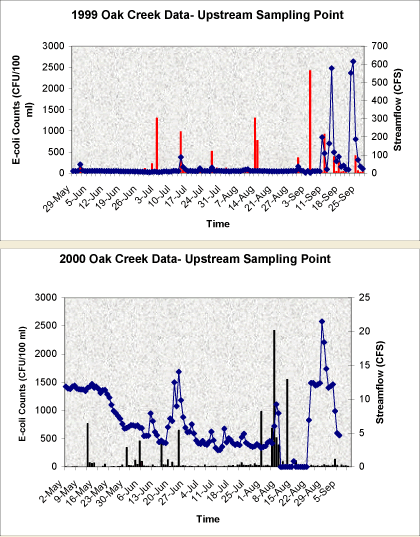
In addition to the upstream site, two other sites – Midpool and Highway Bridge, also showed exceedances for E. coli in the summer of 2000 as shown in the graph below.
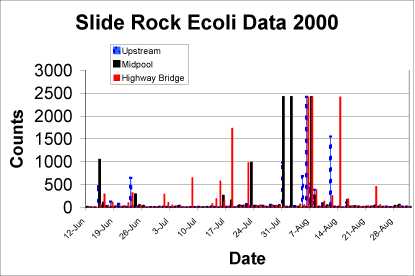
During 1998 and 1999, as part of a Nonpoint Source grant from ADEQ, additional water quality sampling was conducted by Dr. Gordon Southam of Northern Arizona University to identify the genetic distribution of the E. coli bacteria present in water and sediment samples in Oak Creek. The investigation produced results illustrated below.
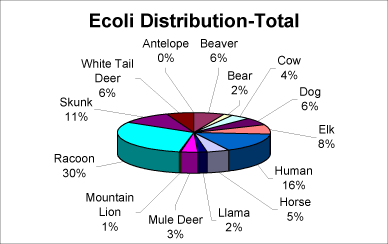
The chart below was compiled from the following upper Oak Creek Canyon sampling stations: Pumphouse Wash, Pine Flats, and West Fork.
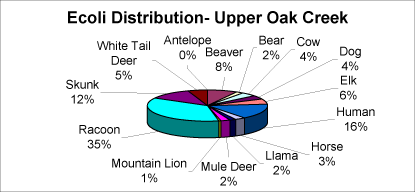
The chart below was compiled from the following lower Oak Creek sampling stations: Upper Slide Rock, Slide Rock Downstream, and Grasshopper Point.
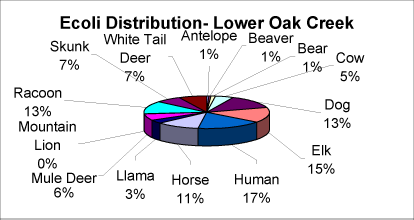
5. Identify and Prioritize Resource Issues
Oak Creek has been designated a “Unique Water” designation due to the diversity and high demand on its uses. Unfortunately, this valuable Arizona resource has experienced occasional deteriorization in water quality, which violates the high standards set for by its unique water classification in Oak Creek Canyon.
Many people have studied the incidents of high bacterial counts. The Impact of Sediment Fecal Coliform Reservoirs on Seasonal Water Quality in Oak Creek, Arizona (Water Resources, vol 35, 1999) (Crabill, et al) reports on the data collected weekly between 1994 and 1996 with the Oak Creek National Monitoring Program. This work reports on both fecal coliform counts in the water column as well as in the sediment. Two distinct major reservoirs of fecal pollution within Oak Creek Canyon were identified in the study. The first area is at the uppermost sampling point (above Pine Flats and the Slide Rock area). Moreover, the report demonstrates that water quality can become impaired without the presence of recreational users. Deterioration of water quality was observed to occur during or shortly after storm events when recreational users were not present.
Dr. Gordan Southam conducted further water quality research during 1998 and 1999 to examine the genetic composition of Escherichia Coli bacteria (The Oak Creek Canyon Escherichia coli Genotyping Project, November 2000). The project revealed high temporal and spatial variability in the sources of E. coli from the water and sediment, which demonstrates that the fecal pollution comes from multiple sources. The fecal pollution in Oak Creek is not a re-growth phenomenon. Moreover, most of the fecal pollution comes from the natural animal populations in the canyon with sporadic and seasonal impacts from human, dog, cattle, horse and llama sources. Single fecal release events, based on the E. coli diversity index comparable to an individual animal suggest that a single animal can cause a direct impact to the sediment and water pollution.
Nonpoint sources of pollution contribute significantly to the fecal coliform levels in Oak Creek. Strategies should be developed to address nonpoint sources of animal fecal material transport. During recent interviews with campground hosts at Banjo Bill, Cave Springs, and Pine Flats campgrounds, the camp hosts revealed that a number of skunks, raccoons, and foxes live in or around the campgrounds. Certain animal populations will increase in close proximity to human activities.
Animals kept by humans (horses, cows, llamas, dogs, etc.) need to be located within the watershed and strategies developed to reduce the nonpoint transmission of fecal coliform.
Stormwater runoff, especially during the summer months, increases the fecal coliform pollution in the water column and the sediment. The Slide Rock State Park E. coli sampling data clearly demonstrates the increases in fecal coliform during rainfall events.
Point source discharges containing E. coli have not been identified in Oak Creek Canyon. Further investigation is needed to document actual sources of wastewater discharges from existing properties. The Slide Rock State Park daily water quality testing over the last several years has revealed random occurrences of high E. coli counts during periods of no rainfall. The occurrences are not repeated on a weekly basis or during high volume usage at Slide Rock State Park. The high E. coli incidents, during non-rainfall periods, demonstrate a possible point source contributor. Further water quality testing over a period of more than once daily is needed to further evaluate the spatial relationships of E. coli dispersal above Slide Rock State Park.
Used diapers along Oak Creek are a documented problem. Efforts should be undertaken to identify the quantity and location of the diaper issue in combination with enhanced trash removal activities along Oak Creek.
6. ACTIONS TO ADDRESS SELECTED ISSUES
OBJECTIVES:
- Reduce sediment fecal coliform reservoir in stream sediments
- Identify relative contributions from sources: runoff, animals within the watershed, septic,
recreation - Accelerate implementation of BMPs for recreation/traffic management
- Increase safety margin for protection of swimmers
- Accelerate septic upgrades/repair schedule
- Develop and implement long-term contingency plan to meet standards
RESULT ORIENTED ACTIVITIES:
OAK CREEK CANYON TASK FORCE:
- Create a website to provide water quality data information from Arizona State Parks, Friends of the Forest, CCEHS, and ADEQ, group activities and public information.
- Coordinate and organize quarterly volunteer trash collection activities along Oak Creek.
- Organize a meeting every other month to review progress of activities and actions.
- Investigate the location and quantity of used diapers found along Oak Creek.
- Develop a Trash/Feces container program for campgrounds, day use areas, and trails.
- Lead the effort to identify horse, llama, cow and dog populations and locations within the Oak Creek watershed.
- Identify stormwater drainage flow patterns for Pine Flat, West Fork, Don Hoel cabins, Junipine Resort and Garlands Resort Lodge for possible sediment removal facilities.
- Review the land use and drainage for the upper watershed of Pumphouse Wash to develop a sampling and sediment control plan.
- Promote need for additional public bathrooms in Oak Creek Canyon.
- Develop, print, and distribute information on need to keep Oak Creek Canyon clean, and free of refuse and fecal deposits.
ADEQ:
- Fund additional DNA genotyping testing for high E-coli events to determine the distribution of contributing sources during high-count periods or events.
- In cooperation with AGFD, US Forest Service and homeowners collect fecal coliform and E. coli samples in water and sediment.
- In cooperation with Coconino County Health and property owners
a. Formalize specific criteria to define “failure” of septic systems
b. Identification of failures and prioritize upgrades - Utilize DNA test results to determine fecal coliform sources. If conclude >50% E. coli is from sources other than human, develop a plan in cooperation with AGFD and US Forest Service for further mitigation.
ARIZONA STATE PARKS:
- Continue daily monitoring of E. coli, flow water level and rainfall at Slide Rock State Park. Enhance sampling plan to include storm event sampling at several locations within the park boundaries. Review the sampling plan to determine if modifications are warranted.
- Provide laboratory facilities for analysis of water samples for sites outside of Slide Rock State Park.
- Participate in the installation of sediment removal facilities within park boundaries.
- Perform an upgrade study to improve the appearance/usefulness of the creekside bathrooms.
- Perform a feasibility study for providing additional creek side bathrooms on the west side of Slide Rock.
- Develop and implement a leak detection test for the existing Slide Rock creek side bathrooms so that the test may be conducted twice per year.
- Develop additional health “triggers” at Slide Rock State Park to reduce the likelihood of violation and increase swimming safety.
Note: All Result Oriented Activities for any government department are dependent on existing budget situations.
ADOT:
- Participate in the installation of sediment removal facilities for road culvert locations along Highway 89A.
- Regularly clean the highway culverts and remove accumulated sediment.
- Assist in the evaluation of the several roadside pullouts for motorists who need to use a bathroom.
- Work with USFS to better manage and limit roadside parking and creek access such that impacts to water quality are reduced.
USFS:
- Continue to support the collection of water quality samples by the Friends of the Forest. Develop a Quality Assurance Plan for the sampling activities.
- Cooperate in the identification and installation of sediment removal facilities.
- Participate in the identification and installation of showers and additional restrooms for the public in the Oak Creek Canyon.
- Cooperate/coordinate with the AGFD to identify animal (elk, whitetail deer, raccoons, skunks, and antelope) populations and migratory patterns in Oak Creek Canyon.
- Consider the upgrading of several campground/day use restrooms into public restrooms through the installation of roadside pullouts.
- Assist the Oak Creek Task Force in identifying horse, llama, cow and dog populations and locations within the Oak Creek watershed, and research acceptable levels of E. coli for wildlife followup.
- Participate in developing a strategy to address non-point and point source of animal fecal transport.
- Work with ADOT to develop a strategy to limit and manage roadside parking and creek access such that impacts to water quality are limited.
AGFD:
- Participate with the US Forest Service to identify animal populations (elk, whitetail deer, beaver, raccoons, skunk) and migratory patterns in Oak Creek Canyon.
- Assist the Oak Creek Watershed Council in identifying horse, llama, cow and dog populations and locations within the Oak Creek watershed.
CCEHS:
- Participate with ADEQ in the formal investigation to identify, sampling and document E. coli sources from onsite wastewater systems (residential and commercial) in Oak Creek.
- Provide priority status to Oak Creek Canyon onsite wastewater system upgrades by performing the site investigations and technical reviews within 1 week of submittal.
- Provide technical review for public restroom onsite wastewater systems and greywater shower systems.
FRIENDS OF THE FOREST:
- Continue weekly water quality sampling of various locations along Oak Creek and report the results to the Oak Creek Watershed Council. Add two additional sampling locations upstream of Slide Rock State Park.
7. Funding Sources
Funding options available for the implementation of the Oak Creek Canyon 2002 Watershed Based Plan are listed below:
- 319 Grant funds from ADEQ for nonpoint source control projects.
- Arizona State Parks operational budget for sampling supplies and equipment along with staff time contributions.
- U.S. Forest Service operational budget for sampling supplies.
- ADEQ water quality monitoring funds for additional DNA genotyping testing.
- Recreation Resource Management facility construction costs.
- ADOT contribution of materials and labor for roadside sediment removal.
8. Educational Outreach
The Oak Creek Watershed Council will provide educational outreach to promote water quality improvements and accomplishments. A web site is planned to provide water quality data, planned cleanup activities and project reports.
Newsletters and press releases will be created periodically to access newspapers.
Public educational and outreach seminars and workshops are planned for participants interested in learning about the watershed, water quality and quantity issues, and develop possible solutions for improvement.
Assistance will be provided to local communities and groups in priority setting for environmental problems and providing a sound technical basis to support environmental decisions.
The Oak Creek Watershed Council will organize, store, and distribute information to the public on the watershed, water quality, and activities.
9. Acknowledgement
This Watershed Based Plan (formerly Watershed Restoration Action Strategy…WRAS) took over two years to prepare and represents the combined efforts of all members of the Oak Creek Watershed Council. A special thanks to Doug Cullinane, P.E., for his effort writing the first draft and subsequent revisions. Also, thanks to Dr. Gordon Southam, staff of the Arizona Department of Environmental Quality, and the United States Forest Service for their valuable input. This Plan is a work-in-progress document. Frequent review, changes, and updates are encouraged.

